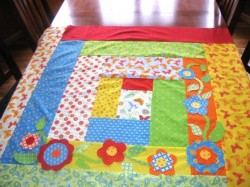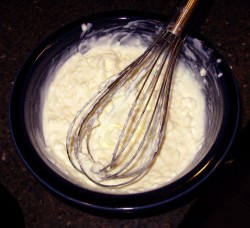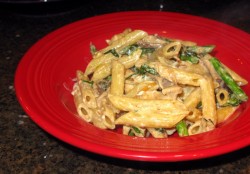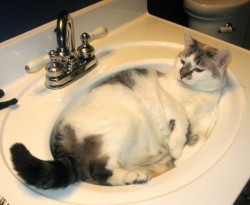My Next Quilt: Claire’s Flowers
I have a newly born third cousin, named Claire Marie, and I decided that I wanted to make a quilt for her.
And I was thrilled to hear that the colors of her nursery were not pastel pinky-lilac-minty-sky. They were, instead, deep, vibrant colors–scarlet, deep yellow, true green and bright blue. I was thrilled because I knew the exact fabrics I wanted to use–I wanted to use the fabrics I had used to make one of Kat’s skirts. They are part of a collection of fabrics designed by Deb Strain, called “Fresh” and they include mod-style flowers, graphical flowers, naturalistic butterflies, polka dots, paisleys and hummingbirds, all in brilliant shades of red, orange, yellow and blue.
The design of the quilt was inspired by the traditional “Log Cabin” quilt block, which is constructed of narrow rectangles of fabric sewn around a central square. These individual blocks are arranged in various ways to create a design of stripes, concentric stripes, zig-zags or medallions. This quilt is just one huge modified log cabin block with the centerpiece being a rectangle instead of a square, and all of the surrounding rectangles cut in different widths. I got the idea for this from a recent quilting magazine–I liked the idea, but didn’t like the fabric they used or the execution fo the design–which was quite plain.
The flowers and vines are my addition–they will be appliqued to the quilt top over the next couple of weeks. I like the contrast between the straight, sleek lines of the patchwork and the sinuous curves of the appliques.
I’ll post more pictures as the work progresses.
Yogurt: Let’s Talk About It
I get emails often from readers who have tried this recipe or that, or many of them and have had fantastic results and they just want to tell me about it.
And I love hearing from my readers, especially when they are happy with the recipes they have tried, but you know, I am just as happy to hear from folks who have questions, or who don’t understand something about a technique, or, heaven forbid, one of my recipes goes seriously awry. I haven’t often gotten any of the last emails, but I did get one a day or so ago, and I wanted to share what I said to the reader, because I think that while I have addressed this issue in the past, it was in the middle of a post, and there was no way for anyone to find it after this.
The issue is the use of yogurt in Indian cookery, and why I almost always specify full fat or two percent yogurt rather than lower-fat or non-fat yogurt in my recipes.
The thing about yogurt is this–if you use full-fat or two-percent yogurt, it is less likely to separate and curdle when you use it in cooking Indian curries. In fact, when I have used whole milk Greek yogurt (the brand I can get consistently here in Athens is Fage), in curries where the yogurt is part of a marinade that is then cooked for the full time on the stove at a simmer or boil, or where the yogurt is added halfway through cooking in order to cook into the sauce, I have never, ever had it curdle and turn a silky sauce into a glumpy mess. Never.Even when I have cooked it in a pressure cooker, which means it is hotter than boiling.
Whole milk regular yogurt, which is not strained generally does not cause any problems. The regular whole milk yogurt brands I like, in order of preference are Brown Cow, Seven Stars and Stonyfield Farm and they all work admirably in curries, though I have found that because they have the thin liquid–the whey–which is mostly water–still intact, they take longer to reduce into a good, thick, clingy sauce. That is why I have switched to using Greek style, strained yogurt exclusively in my Indian cookery.
Why do lower-fat yogurts curdle or separate when they are simmered or boiled?
The problem is the ratio of protein to fat in them. The fats in whole milk, cream and whole milk yogurt surround the proteins in dairy products, and create a buffer between the protein and the heat. (I am vastly simplifying here…but bear with me.) Protein chains, which in their uncooked state are smooth, will knot up and become firm when they are heated–that is why raw and rare meat are softer than well-done, fully cooked meat. If there isn’t sufficient fat mixed in with the milk proteins in yogurt or milk, when it is heated, the proteins will knot up and separate from what fat is there and the whey, causing a sauce to “break” or “curdle.” (This is the same way you can make cheese, by the way–you can heat skimmed milk, or you can add an acidic agent, such as vinegar or lemon juice, which will also cause the proteins to firm up, or you can add rennet, an enzyme, which will do the same thing–firm up and separate the protein molecules from the whey.)
But here then is the problem–what if all you have in your fridge is low-fat yogurt and low fat milk, as happened with the reader who wrote to me about her bad experience in making Safaid Keema Mattar?
Are you doomed to have a beautiful dish with a creamy sauce one second, only to turn your back to get a couple of plates then see a curdled mess where your delicious curry had been only a few seconds before?
No. There are ways around it.
One thing you can do, if you only have low fat or fat free yogurt in your fridge, but you want to make one of my recipes, is check and see if you have any cream in your fridge, too. If you do, you can whisk a few tablespoons of cream into your yogurt before using it, and then cooking it gently on lower heat than I specified in my recipe, for a slightly shorter amount of time–and you should end up with a delicious, smooth creamy sauce.
What if you don’t want to use high fat dairy items like cream or whole milk or whole milk yogurt in the first place? Are you still screwed?
No.
Here’s what you do–you still use your lower-fat dairy products, but you modify the way in which I specify the dairy products to be used in the recipe.
If you use only low-fat or fat free yogurt in a cooked curry, add the yogurt, preferably Greek, or if you use regular yogurt, strain it before you use it–at the very end of cooking. And when you add it, only use 3/4 of the amount listed directly in the sauce. Set aside the remaining 1/4 of the yogurt to be added later.
So here are the steps you need to take to successfully use lower fat yogurt in your curries–whisk your Greek or regular strained yogurt thoroughly before mixing it into the curry. Measure out 3/4 of the amount specified, and when the rest of the curry is cooked, turn off the heat and stir this amount of whisked yogurt into the curry. As soon as it is incorporated and the sauce has warmed itself through residual heat, whisk in the remaining amount to cool the curry further and remove the pan from the stove and serve the curry immediately.
You see, you are not cooking the low-fat or non-fat yogurt at all, which is why I specify that you use Greek or strained regular yogurt for this method. Since you cannot simmer or boil this sauce to reduce the whey and water in it in order to thicken it and concentrate the flavors, you must remove the whey in some other method, and that method is straining it! The Greek yogurt is already strained, which saves you the trouble of doing it, but you can strain your regular yogurt the night before by lining a sieve with cheesecloth and dumping the yogurt into it, then twisting the cheesecloth around it tightly and setting the sieve over a container to catch the whey. If you do this, don’t throw the whey out–you can use it in cooking–you can use it as the liquid in breads, you can use it cooking vegetables and grains, and you can add it to soups or vegetable broths–so long as you are not cooking vegan vegetable broth, of course!
If you must cook the yogurt somewhat and you are not using whole milk yogurt, proceed cautiously and only cook 3/4 of it in the sauce, on a very low simmer, stirring the entire time. If it starts to look suspiciously like it is going to curdle, turn off the heat, move the pan away from the hot burner and stir in the reserved amount of yogurt to cool the curry in order to prevent the incipient curdling action.
If you are using yogurt in an uncooked Indian preparation, such as raita, it doesn’t matter if it is fat free or whole milk–it will not change the texture unduly to use the fat free or low fat product at all.
I hope that this post clears up some of the issues surrounding the use of yogurt in Indian curries and why I often specify whole milk yogurt rather than non-fat or low fat.
Once again–you -can- use lower fat dairy products in Indian cookery and often that is desirable, but you must treat them carefully and heat them slowly, and gently, because they are just not as stable as the full-fat versions.
Culinary April Fool’s Pranks, Japes and Larks
Have you ever played a food or beverage related April Fool’s prank?
When I was about four or five years old, I did.
It all went down like this.
Even as a kid, I am told that I had a wicked sense of humor, and was apt to do things that were unexpected. The April Fool’s Day in question, when this prank occurred was unseasonably warm, and as there had been a great deal of rain the week before, our huge front, back and side yards were endowed with a verdant overgrowth of lush grass–the kind of grass that makes you wish you had a lamb or two to graze upon it, because it is such a shame to just cut it.
But, lacking a sheep, my mother had to cut the grass, since Dad was working long shifts at Union Carbide. Which, truth be told, she didn’t mind doing because, being a farm girl by birth, Mom preferred yard work and gardening to any sort of housework.
The only downside to her mowing the lawn was we only had one of those old non-motorized push mowers, which required quite a bit of muscle power to use–it was pretty decrepit–and strong as Mom was, she was pretty small, and the lawn was really big. And the grass was really tall, making it all the more difficult.
So, there she was, pushing the mower, the whirring sound of its spinning blades making a steady rhythm punctuated by her periodic grunts and sighs.
I was playing on the porch, and after a steady half-hour of mowing without a break, Mom called to me. “Barb, can you go in the house and get me a glass of water?”
I looked up to see my Mom sweating and and winded and I said yes, and dashed in the screen door, letting it slam behind me, to keep our cats from sneaking outside without their harnesses and leashes.
My heart pounding with excitement, I ran into the kitchen. I knew it was April Fool’s Day, and I had not had a chance to ever play a prank on anyone in my life and I always wanted to. And all of the ones outlined in various kids’ publications–such as putting a bit of fishing line on a dollar bill and putting it on the sidewalk and when someone stopped to pick it up, pulling it away from them–seemed lame to me even then. And, the neighborhood where we lived had a distinct dearth of kids in it, so I had no peers upon which to practice my natural bent as a practical joker, and my Dad was at work, so it looked like my Mom was going to be on the receiving end of my prank.
And the inspiration hit me as soon as she asked for a glass of water.
I dragged a chair to the cupboard and pulled down a tall glass–one of the big ones my parents always used for iced tea. Then, I dragged the chair over to the refrigerator, climbed up and pulled open the freezer, and reached in to scoop out five ice cubes which I plunked into the glass, one by one.
Then, I dragged the kitchen chair back to the table instead of over to the sink. Instead, I opened up the low cupboard where Mom stored our canned and bottled goods, and pulled out the big bottle of white vinegar.
And I poured the chilled glass full of vinegar, and swirled the glass around to get it to bead up with condensation a bit.
Then, out the back door I walked, carrying the the glass carefully in two hands to keep from spilling it.
Mom saw it, and saw the ice and smiled, “I wondered what took you so long–you put ice in it–you are such a good girl.”
I smiled as she took the glass from my hands and watched as she tipped back her head and gulped a huge mouthful of it down.
The poor woman was so thirsty, she didn’t even smell the vinegar when she brought the glass up to her lips, she just guzzled the clear liquid in it.
That is, until she choked and spewed the vinegar that was in her mouth on the ground, coughing and sputtering.
“April Fool’s Mommy!” I chimed, giggling with wicked glee.
Mom’s face, usually a dark golden brown (her mother, my Grandma, was in large part Cherokee, so both she and Mom had the dark skin, hair and dark almond-shaped eyes that told their heritage) turned a fierce red and she growled at me, “You little….if I get a hold of you, I’m going to….” and she lunged at me, tossing the glass into a soft pile of cut grass, where the ice cubes and vinegar slithered and drizzled out into the lawn.
That was my cue to take off running as fast as my legs could go, out of the gate, down the driveway, through a gap in the hedge and into the front yard. I have to admit I laughed the whole way, even though I knew my fate was dire if she caught me–it was too funny.
And after me she went, yelling imprecations the whole way–threatening all sorts of corporal punishments if she caught me.
From the front yard to the side yard I ran, then wiggled under the fence back into the back yard, then in the back door, and out the front, so that I was -behind- Mom back in the front yard.
She went around to the side yard, back into the back and didn’t see me, but she could still hear me laughing.
This enraged her and she started yelling again, and dashed out the gate and back down the driveway, figuring I had gone that way. She started cussing so bad, our next door neighbor, Mr. Sigmund, who was pruning his beautiful roses, poked his head over the fence and said, “Judy, Judy–what are you doing? What did Barbra do?”
She said, “She made me drink vinegar, the little–” Well, you can guess what she called me, and the truth is, I don’t blame her a bit for anything she called me that day.
So, Mr. Sigmund, afraid she would kill me if she caught me, came through his gate and joined the chase, huffing as he trotted after Mom, “Now, Judy, calm down, she didn’t mean anything by it, just now, wait!” I ran, still laughing, with my Mom behind me, still yelling, and Mr. Sigmund behind her, still trying to talk reason into her.
Mom was tiring out, so she slowed down and finally stopped. I had doubled back again and was behind she and Mr. Sigmund, and so I hid behind the gate and watched as he caught up to her, and took hold of her, both of them panting and wheezing, Mom with exhaustion, and he with suppressed laughter and exertion. I was breathing hard, and had my hand in my mouth to keep myself from laughing and giving myself away.
“Now Judy–how did you end up drinking vinegar?” Mr. Sigmund asked.
Between gasps and wheezes, Mom told the story, and when she finished, Mr. Sigmund’s snickers overflowed into laughter.
“That’s a pretty good one for such a little kid, you have to admit,” he said.
And then, my Mom who does have a sense of humor, started to laugh, softly at first, and then roaring. Between laughs, she wiped her eyes, and said, “Well, it is no worse than what we kids used to do to Mom.” (This is true–the stuff she and her brothers used to do to Grandma was beyond belief–and they got spanked nearly every night for their shenanigans.)
I crept out from behind the gate and sidled up to Mr. Sigmund, and shielded by his stocky dark green overall-clad frame, peered around and up at Mom.
“I’m sorry,” I whispered. “I just wanted to play an April Fool on someone.”
Shaking her head, Mom reached out and roughly stroked my head. “It’s ok, she said–just go in and get me a cup of real water this time.”
I obediently went inside and did as she asked and all was forgiven. When I gave it to her, she and Mr. Sigmund were still talking in the driveway–he had gone to his side of the fence and had returned to his work with the pruning shears, and she was leaning on the fence, and all was well again.
Mom told Dad about it that night over dinner, and he laughed until he cried–just like Mom did after Mr. Sigmund caught up to her–and asked Mom what she expected-I being the child of both of them.
So, that is the story of my very first April Fool’s joke.
Have any of you ever played a similar food or drink related prank, on April Fool’s Day or any other time of the year?
Half-Local: Penne With Chicken, Asparagus, Mushrooms and Fresh Chevre
It isn’t so hard to eat locally during the winter, that is, if you plan ahead and put food by while it is in season. Canning tomatoes, making jellies, jams and preserves, freezing marinara sauce, pesto and making and canning salsa, and drying and freezing herbs all help families eat the bounty of a local summer while the winter winds blow. Root cellaring, which has become popular again, allows us to eat local potatoes, onions, garlic, squash, pumpkins, turnips, apples and other root vegetables all through the cold season.
But by early spring, most of the stored goodies are gone, and I find myself relying on non-local foods more often, while waiting for the spring-time delicacies to sprout here in Athens County. In March, the blandishments of the Kroger produce aisle work their magic and I find myself buying asparagus from California, a month before it is due to be harvested here in Ohio. And fresh basil, even though there is fresh cilantro I just bought from a local farmer.
Sometimes, I am a bad locavore.
Oh, well. No one should expect to be perfect–just do the best you can for yourself and your family with what you have.
The truth is–the use I put that asparagus and basil to is a good one–most of the other ingredients, except for the penne, lemon juice, Aleppo pepper, olive oil, and the onions, came from local sources. The chicken, chevre, garlic and fresh shiitake were all locally grown and produced, and the chicken stock was made in my kitchen from local chickens and vegetables and frozen months ago.
So I think of this dish as half-local. Which is not bad for Ohio in March.
Now, this recipe could very easily be converted to a vegetarian pasta dish, and with no real loss of flavor. In fact, I think that I would prefer it without the chicken, but Zak and Kat really wanted chicken for dinner last night, so in it went. But, to convert it to a vegetarian pasta, just use tomato-free vegetable broth instead of chicken stock and leave out the chicken. When you saute the mushrooms, toss them in a bit of flour, just as I instruct you to do with the chicken.
The flour serves the purpose with the chicken and giving a dry surface for cooking that will lead to a nicely browned crust, and with mushrooms, it does a little bit of the same thing. But its secondary purpose, that of thickening the sauce, and adding a brown flavor to the sauce, is accomplished just as easily with the mushroom version as it is with the chicken.
As for the fresh basil–you could use another fresh herb in its place, but I am desperately fond of the combination of sweet asparagus and sweet basil–they are so lush when combined together–especially when paired with tart, fresh chevre.
At any rate, here is last night’s dinner, which Kat, Zak and I all loved, and which will probably appear again, in various incarnations, over the next month or so as the local asparagus comes into season.
1 1/2-2 cups thin young asparagus, bottoms trimmed and cut into 1″ lengths
3 tablespoons olive oil
1 cup onions, thinly sliced
1/2 teaspoon salt
1 cup thinly sliced fresh shiitake mushrooms, or whatever fresh mushroom you can get
3/4-1 cup chicken broth or vegetable stock
1/4 cup all purpose flour
1/2 pound boneless skinless chicken breast, trimmed and cut into 1/4″X1/2″X1″ slices
3 tablespoons garlic, peeled and minced
1/4 teaspoon Aleppo pepper flakes, or freshly ground black pepper to taste
1/2 pound penne pasta
6 ounces fresh chevre
1/3 cup fresh basil leaves cut chiffonade–into very thin strips–or roughly chopped
1/2-1 teaspoon lemon juice
salt to taste
whole basil leaves or sprigs for garnish
Method:
Bring a pot of water large enough to cook your pasta to a boil. Dunk the asparagus into it and when it turns brighter green, immediately remove it with a skimmer and drain it. Leave the water on to boil, and when it is time to cook your pasta, cook it in there. (Yes, I am saving water and time here, and hopefully adding some of those water soluble vitamins you lose by blanching your asparagus into the pasta.)
Heat the olive oil in a heavy-bottomed, deep skillet or Dutch oven. Add the onions, and sprinkle with the salt. Cook, stirring, until the onions are a light golden brown.
Add the mushrooms, and cook, stirring, until the onions turn a deeper gold color and the mushrooms shrink and brown a bit themselves. Deglaze the pan with a little bit of the stock or broth–not all of it–you will need it later. Maybe a couple of tablespoons at most.
Toss the chicken with the flour until it is well coated. Add it to the pan with the mushrooms and onions and cook, stirring until it is mostly brown and white with very little pink showing. Add the garlic and the Aleppo pepper or black pepper, and cook, stirring, until there is no pink showing, but the chicken is not quite done.
Put the penne in the pasta water and cook until it is al dente. (Now the truth is, you can finish cooking the chicken before you add the pasta to the water if you don’t trust yourself to get the timing just right on having the pasta and chicken done and ready to go at the same time. The chicken can wait, but the pasta cannot.)
Deglaze the browned bits of flour off the bottom of the pan with most of the rest of the broth or stock–leave some behind for thinning the sauce if necessary–just a tablespoon or two should do it– by adding it bit by bit and scraping up the flour and chicken bits. Turn the heat down on the pan to a simmer and cook until the chicken is done and a thick sauce clings to the onion, mushroom and chicken pieces, with very little left in the pan.
Drain the pasta and add to the pan. Before stirring it in, add the asparagus pieces, the basil and the chevre.
Turn off the heat, and stir well–two wooden spoons help this process along–until the pasta is coated with the sauce, and everything is mixed together. If it is too thick and glumpy, add a bit of the reserved stock–a tablespoon or two should suffice and keep stirring. Add the lemon juice and the salt to taste and toss until well combined.
Serve in warmed bowls, and garnish with reserved whole basil leaves if you remember them, which I didn’t.
This dish will serve three to four adults and one hungry toddler easily. If you want, you can add more pasta, more chicken or more of everything to stretch the dish farther.
Weekend Cat Blogging: Schmoo In His Natural Habitat
Yes, I just had an old photo of Schmoo as my illustration for the last post, the one about books.
So, why am I posting this one I took earlier this week?
So you can see how much Schmoo has grown.
And, so you can see him in his natural habitat–the bathroom sink.
I think he believes the sink is a Schmoo nest.
He sleeps in it. And curls up in it, and lounges, washes his paws and generally looks ridiculous.
And if you turn on the water, he doesn’t run away–that just makes it all the more interesting.
He is a VERY STRANGE CREATURE.
Powered by WordPress. Graphics by Zak Kramer.
Design update by Daniel Trout.
Entries and comments feeds.







